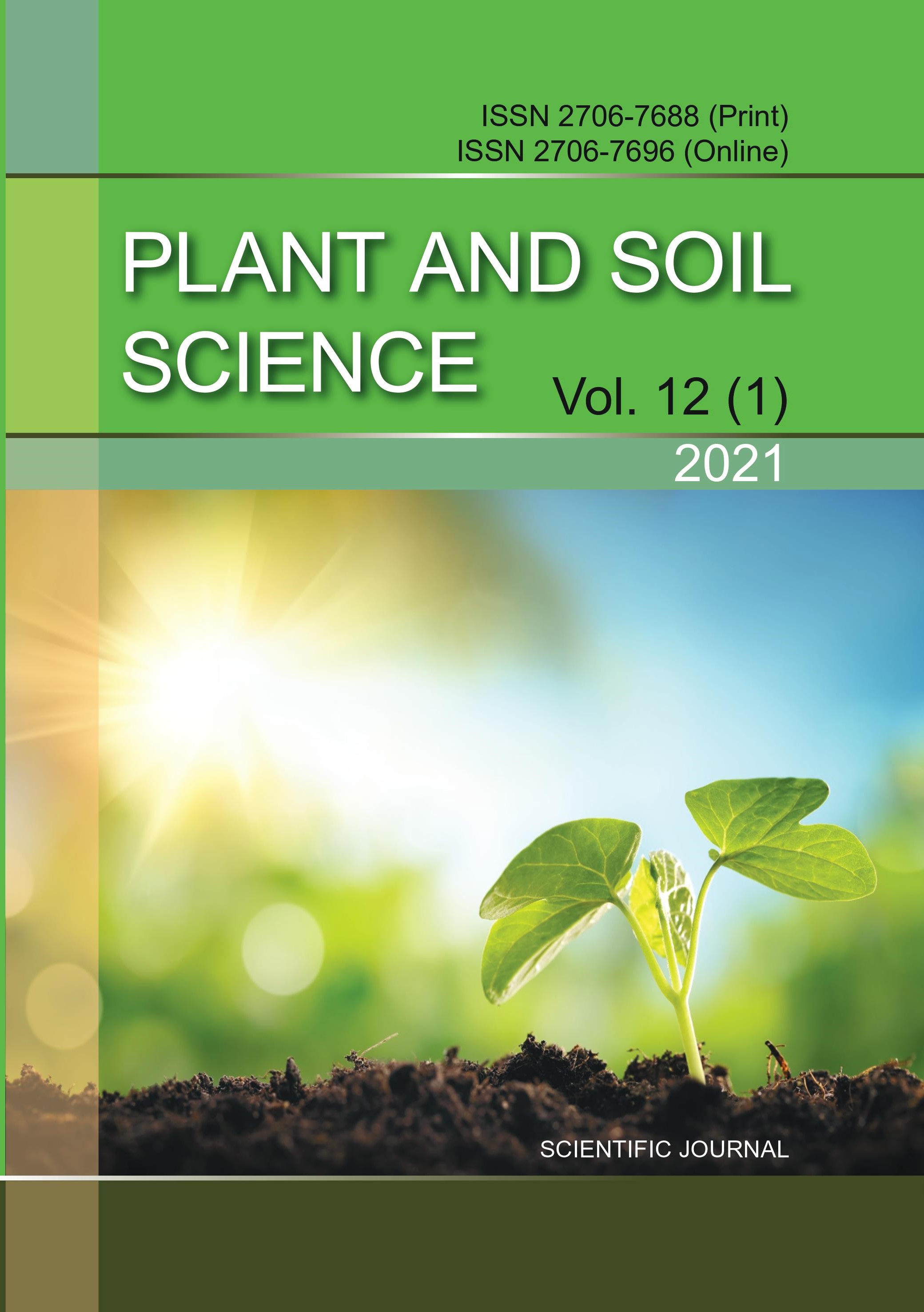Phytopathogenic mycobiom of raspberry varieties (Rubus idaeus L.) Joan J and Himbo-top in the conditions of organic production
DOI:
https://doi.org/10.31548/agr2021.01.094Keywords:
raspberry plant, rhizosphere, mycobiota, radial growth rate, vegetative organs of plants, isolates, phytopathogens, organic productionAbstract
The results of researches of influence of raspberry plant varieties on the species composition of micromycetes in rhizospheric soil and on vegetative organs of plants in the conditions of organic production are given. The mycobiota of raspberry varieties Joan J and Himbo-Top during plant ontogenesis was analyzed and the species composition of phytopathogenic micromycetes in the rhizosphere and on plant leaves was established. It was found that the population is dominated by fungi of following species: Septoria rubi, West, Botrytis cinerea, Pers, Aspergillus niger, V. Tiegh, Alternaria alternata, (Fr.) Keissl., Fusarium graminearum, Schwabe, regardless of the phase of ontogenesis of plants that produce mycotoxins, and can cause disease in animals and humans. According to the results of research, it can be assumed that in the phase of inflorescence growth in the mycobiota of rhizospheric soil and on the vegetative organs of raspberry plants of Joan J and Himbo-Top the greatest competitiveness can be characterized by isolates of fungi Septoria rubi and Alternaria alternata. The obtained results indicate a significant differentiation of the studied varieties by the reaction of interaction between plants, microorganisms and the environment. Thus, while in the mycobiota of rhizospheric soil and vegetative organs of raspberry plants of the Joan J variety during intensive fruiting of plants the isolates of Aspergillus flavus fungi were characterized by the greatest competitiveness, in Himbo-Top cultivar the highest rates of radial growth were shown by isolates of Aspergillus oryzae and Alternaria alternata
References
Archer, L., Carroll, J., Heidenreich, C., & Pritts, M. (2016). Production and IPM Guide for Organic Raspberries and Blackberries. New York State Integrated Pest Management Program, 59 [In English]
Bilay, V. I., Dudka, I. A., Vasser, S. P. & Elanskaya, I. A. (1982). Metody eksperimentalnoy mikologii. Naukova dumka, 548 [In Russian]
Furtat, I., Danshyna, A. & Mankovska, O. (2020). Harakterystyka fitopatohennyh I toksykohennyh vlastyvostey hrybiv rodu Fusarium, izolovanyh iz zerna Triticum aestivum L.
https://doi.org/10.18523/2617-4529.2020.3.26-34
Hvozdiak, R. I., Pasichnik, L. A., Yakovleva, L. M., Moroz, S. M., Lytvynchuk, O.O., Zhytkevych, N.V., Hodos, S.F., Butsenko, L.M., Dankevich, L.A., Hrinik, I.V. & Patyka, V.P. (2011). Fitopatohenni bakterii. Bacterialni hvoroby roslyn. Interservis, 1, 444 [In Ukraine]
Ostapenko, V. M., Hradchenko, S. I. & Makovkin, I. M. (2013). Stiykist perspektyvnyh sortiv malyny (Rubus ideaus L.) proty osnovnyh hvorob zs steblovoiu formoiu proiavu. Sortovyvchennia ta ohorona prav na sorty Roslyn, 2, 50-53 [In Ukraine]
Parfeniuk, A. I. & Beznosko, I. V. (2012). Intensyvnist sporoutvorennia fitopatohennyh hrybiv na sortah ta hibridah pertsia solodkoho. Visnyk Harkivskoho natsionalnoho ahrarnoho universitetu. 3(27), 104-108 [In Ukraine]
Parfeniuk, A. I., Sterlikova, O. M., Beznosko, I. V., Blaginina, A. A., Horhan T. M., Sahanovska V. I., Tyshchenko, A. F. & Kovtun, V. V. (2014). Ekolohichne otsiniuvannia sortiv pshenytsi za vplyvom na formuvannia populiatsii fitopatohennyh hrybiv. Kyiv, 39 [In Ukraine]
Parfeniuk, A. I., Sterlikova, O. M., Beznosko, I. V., Blaginina, A. A, Tyshchenko, A. F. & Kovtun, V. V. (2015). Biobezpeka vyroshchuvannia sortiv silskohospodarskih kultur. Visnyk ahrarnoi nauky, 11, 57-60 [In Ukraine]
Parfeniuk, A., Mineralova, V., Beznosko, I., Lishchuk, A., Borodai V.& Krut V. (2020). Mycobiota of the rhizosphere of raspberry plants (Rubus idaeus L.) under the influence of varieties and new fertilizers in conditions of organic production. Agronomy Research Journal. 18(4), 2550-2558. https://doi.org/10.15159/ar.20.182 [In English]
Polianchikov, S. & Kapitanska, O. (2017). Pozakoreneve pidzhyvlennia: mozhlyvosti i pomylky. Ahroindustriia, 9, 32-36 [In Ukraine]
Prakash, B., Shukla, R., Singh, P., Mishra, P.K., Dubey, N.K. & Kharwar, R.N. (2011). Efficacy of chemically characterized Ocimum gratissimum L. essential oil as an antioxidant and a safe plant-based antimicrobial against fungal and aflatoxin B1 contamination of spices. Food Research International, 44(1), 385-390. [In English]
https://doi.org/10.1016/j.foodres.2010.10.002
Sekizuka, M., Qi, JW, Aomori, T., Okada, Y.& Nakamura, K., (2014). Effect of a Dietary Supplement Containing Raspberry Ketone on Cytochrome P450 3A Activity. Pharmaceutica Analytica Acta.
https://doi.org/10.4172/2153-2435.1000302
Ternovyi, Yu., Havliuk, V. V.& Parfeniuk, A. I. (2018). Ekolohichno bezpechni ahrotehnolohii. Ahroekolohichnyi zhurnal, 4, 50 [In Ukraine]
Tolouee van T. M., Alinezhad, S., Saberi, R., Eslamifar, A., Zad, S. J, Jaimand, K., Taeb, J., Rezaee, M.-B., Kawachi, M., Shams-Ghahfarokhi, M. & Razzaghi Abyaneh, M. (2010). Effect of Matricaria chamomilla L. flower essential oil on the growth and ultrastructure of Aspergillus niger. International Journal of Food Microbiology, 139(3), 127-133 [In English]
https://doi.org/10.1016/j.ijfoodmicro.2010.03.032
Wang, Shiow, Y. & Lin, Hsin-Shan. (2000). Antioxidant Activity in Fruits and Leaves of Blackberry, Raspberry and Strawberry Varies with Cultivar and Developmental Stage. J. Agric. Food Chem., 48(2), 140-146 [In English]
https://doi.org/10.1021/jf9908345
Zvyagintsev, D. G. (1991). Metody pochvennoy mikrobiologii I biohimii. MGU, 304[In Russian]
Downloads
Published
Issue
Section
License
Relationship between right holders and users shall be governed by the terms of the license Creative Commons Attribution – non-commercial – Distribution On Same Conditions 4.0 international (CC BY-NC-SA 4.0):https://creativecommons.org/licenses/by-nc-sa/4.0/deed.uk
Authors who publish with this journal agree to the following terms:
- Authors retain copyright and grant the journal right of first publication with the work simultaneously licensed under a Creative Commons Attribution License that allows others to share the work with an acknowledgement of the work's authorship and initial publication in this journal.
- Authors are able to enter into separate, additional contractual arrangements for the non-exclusive distribution of the journal's published version of the work (e.g., post it to an institutional repository or publish it in a book), with an acknowledgement of its initial publication in this journal.
- Authors are permitted and encouraged to post their work online (e.g., in institutional repositories or on their website) prior to and during the submission process, as it can lead to productive exchanges, as well as earlier and greater citation of published work (See The Effect of Open Access).

